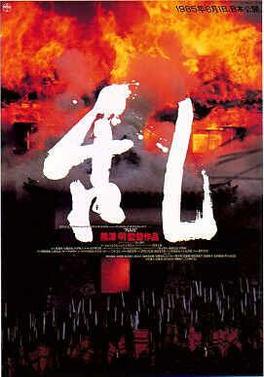SYNOPSIS:
This is Akira Kurosawa's epic reinterpretation of "King Lear". It
deals with a very dysfunctional royal family. "Chaos" ensues when the
reigning warlord decides to retire and leave his kingdom to his first born of
three sons. Naturally, the other two son do not accept the decision with grace.
The eldest is under the sway of a Lady MacBeth type schemer. A civil war
whittles the family down. The movie features two amazing battles and thousands
of costumed extras.
BACK-STORY: “Ran” was the last epic movie by the great Akira Kurosawa. It took
ten years to make, partly because of trouble finding financing. It was released
in 1985. Kurosawa, who was an accomplished artist, painted brilliantly colorful
storyboards of all the scenes while he waited for funding. He was well into his
seventies and going blind before the filming began. The movie is famously based
on “King Lear”.
The title word is translated into “chaos”. At $12 million it was the most expensive Japanese film at
the time. It was critically acclaimed and won an Oscar for Costume Design (the
1,400 handmade costumes took more than two years to make) and was nominated for
Cinematography, Art Direction, and Director. It was not a box office success,
however.
Belle and Blade = N/A
Brassey’s = 5.0
Video Hound = 5.0
War Movies = N/A
Military History = 76
Channel 4 = 62
Film Site = no
101 War Movies = yes
Rotten Tomatoes = 17
ACCURACY: The movie is set in the period of the “Warring States” in 16th Century Japan. This was the period when rival warlords called daimyos battled for control of regions of Japan. Kurosawa based Hidetora on the legendary daimyo Mori Motonari who had three sons and used the arrow analogy to explain to them how they needed to remain loyal to each other. That particular story had a happy ending. Kurosawa decided to imagine what would have happened if the sons were bad.
The warfare in “Ran” is fairly accurately depicted. The feudal Japanese armies did consist of foot soldiers and cavalry. The armor was accurate for that era. We do see the transition from the samurai with their bows and swords to the peasant levies with their new European style arquebuses. Kurosawa accurately foreshadows the death of the bushido code and its traditional ways of fighting. Modern is not always better.
Tactics in the final battle are off a bit. A competent general (perhaps Jiro was incompetent) would not have led off with a cavalry charge, especially if he could clearly see fire-armed men stationed in the woods to ambush them. Jiro would have led with his infantry, but then we might not have had the thundering hooves scene with the numerous dehorsings.
One other thing, I was not aware that an arquebus could be fired continuously without reloading. Not once in the battle scenes did I see anyone reloading.
CRITIQUE: This is a grand movie in every sense of the word. It is the closing argument for Kurosawa being one of the greatest movie directors. Everything is over the top – the acting, the dysfunctionality, the battle scenes, the visuals. Hell, they built a castle and then burned it to the ground! They spray painted an entire field gold and then did not use the shot in the film!
The themes are powerful. They include the ripple effect of a decision. At the opening, Hidetora decides to pass on his authority to his oldest son and look what happens. Second, the gods have abandoned us. There are several references to this by characters. Third, what you did in your past can literally and figuratively come back to haunt you. Fourth, a family can become a battleground that leads to actual battles.
The imagery is striking. The actor who portrays Hidetora wears traditional Noh makeup that sets his character apart and gives him a demonic look. Kurosawa uses clouds to symbolize the moods of the scenes. Storm clouds – watch out. Much of the film is shot from a distance, even the intimate scenes.
The acting is best described as Japanese. There is a lot of shouting and emoting. I did not particularly like Hidetora’s portrayer, Tatsuya Nakadai. He chewed the scenery even more than what you expect in a Japanese flick. His death scene was giggle-inducing. However, Meiko Hrada as Lady Kaede makes up for his faults. She is chillingly amazing. There is also the fool Kyoami who can be aggravating but serves the purpose of being the opposite of the typically macho male characters.
The battles are justifiably famous. They are messy as I would imagine a real battle would be. You see the fog of war depicted from the comfort of your home. If it were not for the colorful banners, you would not be able to tell which side is which. These scenes are also pretty graphic for a 1980s movie. One soldier takes an arrow in the eye and another holds his severed arm (note to Spielberg – that would work well in a D-Day movie). There are enough killings to sate even the most bloodthirsty war movie buff.
CONCLUSION: Even though you will have to read the subtitles, it’s well worth the watching. The battles within the family and on the battlefields are intense. It is not a standard war movie, but you cannot argue against combining Shakespeare with battles. As the British would appropriately say, it’s a bloody good show!

No comments:
Post a Comment
Please fell free to comment. I would love to hear what you think and will respond.